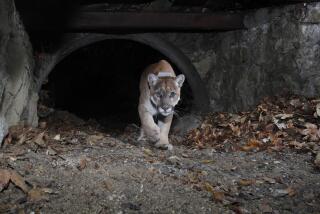Tortoises to Get VIP Treatment
PALO VERDE, Calif. â After seven years in the Marine Corps, Sgt. Johnnie White of Newark, N.J., has a new skill: tortoise spotting.
White is among 30 noncommissioned officers ordered to make sure no threatened desert tortoises are harmed as 1,800 Marines and 500 vehicles make a 170-mile trek this week from the Armyâs Yuma Proving Ground in Arizona to the base at Twentynine Palms.
Things have changed a bit since Army Gen. George Patton used an 18,000-acre chunk of this desert to train his tank corps for combat in North Africa.
When Patton needed water, he tapped into the Colorado River. When his tanks broke down, he buried them. There is no evidence he gave any thought to the desert tortoise.
âIt was a different world back then,â said Lt. Col. Stuart Dickey, top planner for the current exercise. âAnd, of course, he was Patton.â
Although desert training is the raison dâetre of Twentynine Palms, there are some things that cannot be done even at that sprawling base in the high desert of San Bernardino County.
This 170-mile exercise allows the Marines to test their skills at maintaining lines of communication for a spread-out column in rugged terrain--the kind of training that might prove handy in places like Iraq and North Korea.
No rounds will be fired. No opposing force will play the role of enemy. The goal is to train Marines to move troops and equipment quickly and stay in constant touch with a moving command center in an environment where cell phone coverage, for example, is spotty at best.
Marines were allowed Tuesday to build a 450-foot-long temporary âfloating ribbon bridgeâ across the Colorado River just south of this Imperial County farming hamlet south of Blythe.
To get permission to cross the desert--much of which is controlled by the U.S. Bureau of Land Management--the Marines needed upward of 20 permits from various state, local and federal agencies.
Moving the troops will take only a few days. Getting the permits took eight months. To lessen opposition, the Marines promised to travel only on established roads and camp only in approved areas.
The corps would like to make this off-base training exercise, dubbed Desert Scimitar, an annual event. But top officers know that the surest way to keep that from becoming a reality is to run afoul of the Endangered Species Act.
Hence the reptile-safety instruction given to White and the others while bivouacked at Yuma last week awaiting the start of their westward journey.
Included in the training was how to spot a tortoise, where to look for a tortoise, and what to do if you see a tortoise in distress.
âThe only way that I can touch a tortoise is if it is in imminent danger of getting killed by getting run over,â White said Tuesday. âEven then, Iâve got to notify the chain of command.â
It is Whiteâs job to check under and around the Humvees, armored personnel carriers, 5-ton trucks and other vehicles for tortoises.
Stickers are being applied to vehicles: âNotify Monitor if You Find a Tortoise.â
If White or another tortoise-watcher, riding in lead vehicles in the convoy, spots a tortoise in peril, he is to immediately notify his lieutenant by cell phone or radio.
The lieutenant will then notify Dickey, who is coordinating Desert Scimitar for the 1st Marine Division, based at Camp Pendleton.
If Dickey feels the tortoise needs moving, he will contact a federally approved tortoise handler, a civilian hired at $85 an hour to follow the Marines on their trip.
The land bureau and Fish & Wildlife Service are monitoring the exercise to make sure the tortoises are safe. The Tucson-based Center for Biological Diversity is also on alert.
This is mating season for the tortoise, and the love-struck creatures get frisky and mobile.
âI hope the Marines stay on established roads, rather than grooving ruts in the desert,â said Daniel Patterson, desert biologist with the diversity center. âThis is a very vulnerable time for the tortoise.â
In planning the exercise, Dickey chose as a top assistant not an artillery officer or rifle-toter but a lawyer.
Capt. Joseph Lorie, a member of the Judge Advocate General Corps, was in charge of navigating layers of bureaucracy to get the necessary permits. The final permit was received with only days to spare.
Tuesday, as the temperature soared above 110 degrees, Lorie, clad in unlawyerly Marine camouflage, stood on the riverbank and expressed satisfaction that the Marines would be able to return.
âOur goal is to cooperate,â Lorie said. âWe donât want to burn any bridges here,â metaphorically speaking.
For White, a communications specialist, cooperation means being ever vigilant for the slow-moving but politically connected tortoise, which can grow to 12 inches across and 15 pounds and is Californiaâs state reptile.
âIn peacetime,â White said, âyouâve got to watch out for critters.â


